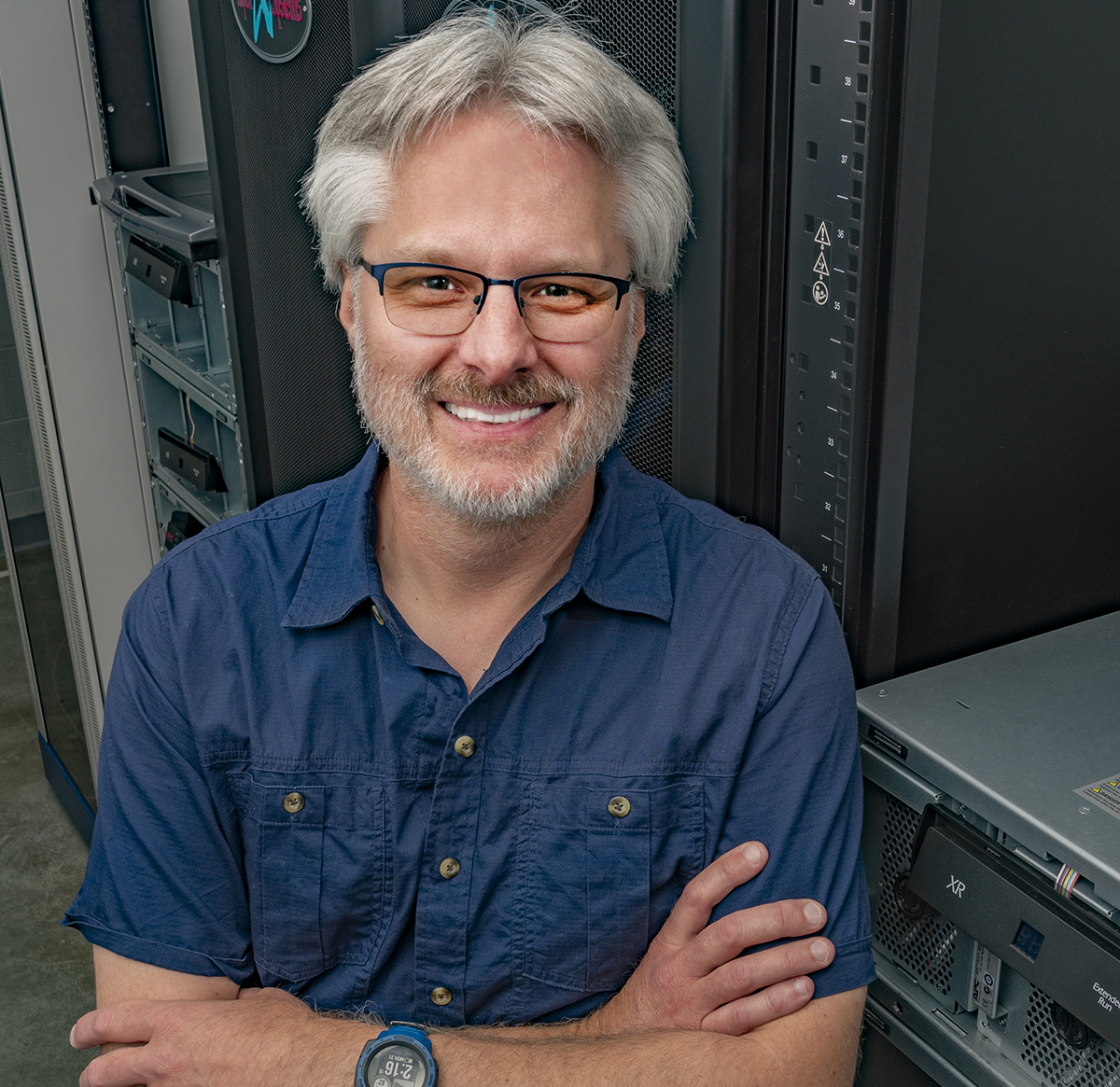To the Stars
From NASA-funded research to mentoring students, Brian Thomas uncovering the cosmos

Brian Thomas stands in the server room in Stoffer Science Hall, which houses a new 40-core machine purchased with funds granted by Washburn for the High-Performance Academic Computing Environment. HiPACE is used for research and teaching by students and faculty in the physics and astronomy, chemistry and computer information sciences departments. Photo by Jeremy Wangler
From The Ichabod - Fall 2023
By Angela Lutz
Imagine, for a moment, a massive star exploding in the depths of space. The resulting supernova would be brilliant and catastrophically violent, sending harmful X-rays and bits of atoms rippling through the cosmos, penetrating anything in their path. This persistent radiation can last for centuries and reach planets hundreds of light years away – yes, planets like Earth, where there is hard evidence for such an event about 2.5 million years ago. In the most extreme and unlikely scenario, this could trigger a similar event and corresponding mass extinction. For Brian Thomas, Washburn University physics and astronomy professor, taking a closer look at these kinds of existential threats is all in a day’s work.
“In the cases we’ve examined, these events contribute to the destruction of ozone molecules in the Earth’s upper atmosphere, which protect us from ultraviolet light from the sun,” Thomas said. “This can cause negative effects on humans and other organisms, and in some cases, we could get an increase in background radiation exposure that could cause a rise in cancer rates. We think this kind of major event has happened a few times in Earth’s history.”
The likelihood of such an event occurring again anytime soon is small, but Thomas has discovered people love talking about it. This year, he coauthored two published studies on the topic. Over the years, he has collaborated on nearly 30 peer-reviewed articles on this and subjects including the ecological impact of radiation events and the connection between radiation events and mass extinctions. A passionate researcher, Thomas has also served as a principal investigator on multi-year research projects funded by NASA. He finds most people have a certain degree of curiosity about how supernovae can impact their everyday lives.
“I think the connection between these very distant stars and the very present life on Earth is really fascinating, and I think that resonates with people,”
Thomas said. “On the whole, people are very interested in past life on Earth – people love dinosaurs – and astronomy is interesting in and of itself. I get to study a variety of topics and have worked with people across the sciences to try to connect these big-picture questions.”
Thomas’ prolific career is the culmination of a lifelong fascination with what he calls “the big questions.” His interests clicked when he took physics and calculus in high school and discovered some of the mysteries of the universe could be understood through math. Ultimately, he earned his doctorate in philosophy at the University of Kansas before coming to work at Washburn in 2005.
“I was fascinated by how we could basically explain the universe using equations,” Thomas said. “I also have an interest in philosophy and cosmology, which is essentially the study of the origin and structure of the universe. These struck me as the biggest questions one could ask.”
In his work at Washburn, Thomas strives to involve students in research as much as possible. For Cody Ratterman, bs ’21, learning how to use an intermediate-level climate simulator alongside Thomas fueled his interest in climate science. The program allowed him to run computational experiments that demonstrated the complexity of the Earth’s climate system and how small changes can have big impacts. Today, Ratterman is pursuing a doctorate in climate science at Utah State University, and he credits Thomas with putting him on the path to his future career.
“He was really open to new ideas while giving me challenging opportunities with just enough help to get me started,” Ratterman said. “The astrobiophysics work he focuses on with supernova events includes people from lots of different backgrounds collaborating to fill in the gaps. It seems he has an opportunity for almost any young researcher regardless of their background or experience level. If it weren't for him, I wouldn't be pursuing graduate school, climate science or a research-oriented career.”
Students have contributed to Thomas’ research papers and helped him build tools and software for data analysis.
“I’ve had some incredibly capable students who have done some fantastic work,” Thomas said. “It’s exciting to see students go from not knowing anything about how to approach these research questions to making significant progress and contributing to science.”
Going forward, Thomas plans to keep asking the big questions through research and encouraging students to do the same, driving their continued interest in physics and astronomy. He’s currently collaborating with other scientists on a project looking at how Earth’s climate millions of years ago may have been affected by clouds of gas and dust in the galaxy – and through this possibly gaining a glimpse at what the future could hold.
“I’ve been fortunate at Washburn to be able to teach subjects I really enjoy and influence a lot of students in both the specialization and general classes,” Thomas said. “I love helping students gain skills they can use in whatever they do. It’s satisfying to see them grow in that way.”